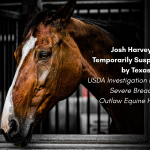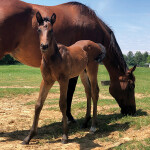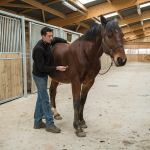As winter slowly fades to spring it is an ideal time to do some spring cleaning in and around the barn. One area to focus on is making sure you’re prepared if your horse has an emergency or becomes ill.
We asked Kyla Szemplinski, MS, Extension Agent with UT and TSU Shelby County Extension office to provide a checklist of things every horse owner should have in case of an emergency, and some tips for when, and if an emergency should arise.
According to Kyla Szemplinski, MS: ALWAYS have multiple equine first aid kits on hand. It is recommended to have a few in the barn and one that travels in the horse trailer at all times. AAEP recommeds having a first aid kit with the listed supplies in the image above.
Some first aid kits can be bought from local equine hospitals while most owners assemble their own first aid kits. Make sure your first aid kits are labeled and put in the tack room, feed room and/or barn office. Keep the first aid kit well stocked and clean! Keeping it in a temperature-controlled environment is best since some topical ointments and sprays are temperature sensitive.
Another tip would be to have emergency contact phone numbers and addresses listed all over the barn and outside the riding arena. Numbers listed should include:
- Veterinarians/local equine hospital
- Farrier(s)
- Equine dentist
- Barn manager and assistant manager(s)
- Head trainer and assistant trainers
Also know how far your local state’s University Veterinary Hospital is in the case your horse needs to be admitted there. These hospitals have the most advanced diagnostic tools for special cases.
In case of an Emergency: REMAIN CALM!
Panicking will only make your thoughts scatter and make the situation worse.
- Try NOT to be alone during an emergency. Always make sure another human is at the barn with you in case of an emergency (human or horse).
- Make sure you and any other humans are OK. Call 911 for any life-threatening human injuries!
- Call your veterinarian IMMEDIATELY in ALL life-threatening horse injuries (uncontrollable bleeding, elevated temperatures, puncture wounds, signs of colic, eye injuries, difficulty breathing, suspected fractures or other soft tissue injuries). It is always beneficial to have multiple veterinarians at your disposal in case your usual veterinarian is unavailable to come.
- Get the horse to a safe, calm and clean environment. Limit movement if possible.
- Try to keep the horse calm. If the horse is thrashing around, wait until the horse calms down enough to do first aid. Your safety is the number one priority!
- Take the horse’s vitals and if possible, give those vitals to the veterinarian over the phone. The more information the vet has before arrival, the faster she/he can get straight to the problem. Take and send pictures as well.
- Monitor vitals until the veterinarian arrives. (See Vital Signs in Image B on page seven)
- Try to avoid giving food to your horse, especially if they are showing signs of colic! Only offer water.
- For uncontrollable bleeding, wrap the affected area with a pressure bandage. Do not remove it even if the bandage becomes blood soaked. Add more gauze on top of it and apply more vet wrap.
- For foreign objects lodged in your horse’s body, DO NOT REMOVE the object. Wrap the affected area with bandages.
- If your horse is showing signs of colic, administer Banamine either intravenously (only if you are comfortable doing so) or at minimum orally to help with pain management. NEVER administer Banamine intramuscularly.
No horse owner likes to think about emergency situations with their horses, but being prepared is not only wise, it is essential. As spring approaches and riders find themselves in the saddle more make sure you have first aid kits in easy to find locations, and outlined emergency preparedness plans in place so you and other individuals in the barn can quickly spring into action if an emergency should arise.









